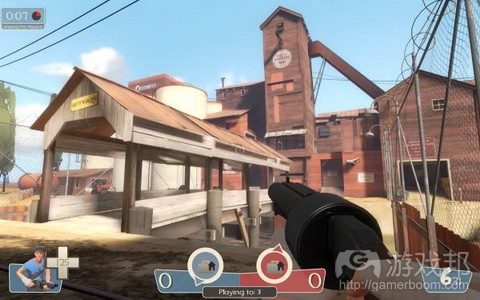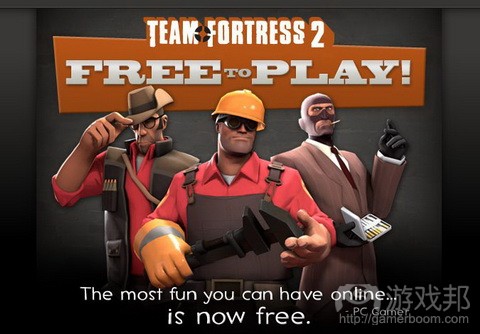开发者谈《军团要塞2》的免费模式转换过程
作者:Patrick Miller
2011年6月,维尔福软件公司将自己已发行4年的第一人称射击游戏《军团要塞2》转变成免费模式——且最终将自己收益提高12倍。
维尔福的Joe Ludwig日前举行一次GDC会议,谈论持续4年的内容更新&调整及社区粘性如何帮助他们顺利将AAA盒装游戏《军团要塞2》转变成基于虚拟交易的免费模式游戏。
更新内容保持用户兴趣
制作包含额外内容的庞大更新包是维持用户兴趣及扩大用户基础的关键。
Ludwig表示,“虽然所有游戏更新内容都在游戏发行后立即出现,但直到2008年医疗更新内容问世,我们的营收才出现显著提高。一次性添加如此多内容,能够给媒体和社区制造谈论话题,这让更多用户着手试验这款游戏。”
但维尔福很快发现,AAA盒装游戏的商业模式不符他们的开发策略。
“问题在于,若你推出的是AAA盒装游戏,唯一能够给你带来新收入的就是尚未购买游戏的用户群体。这促使你创造新内容吸引新用户群体。创造满足既有用户的游戏与制作吸引新用户的内容存在一定冲突。”
为解决这一冲突关系,维尔福继续推出呈现新地图、游戏模式、武器,甚至是全新游戏机制(游戏邦注:如游戏道具、市场情境和交易机制)的更新内容,旨在向免费模式过渡。
社区粘性是保持用户兴趣的关键
为创作出成功的免费游戏,维尔福需确保用户会持续返回《军团要塞2》中。它采取的一个策略就是,以尽可能多的方式吸引玩家社区的眼球。
Ludwig举例《军团要塞2》的Sniper更新内容。各更新内容都先以预告片呈现,影片会含蓄提及游戏将出现的新道具或新功能,维尔福开发人员会查看社区在论坛中给出的反应,以此判断哪个元素更引人注意。Ludwig表示,“我们发现,论坛用户表示,他们希望Pyro能够点燃烧狙击手的箭。坦白讲,我从来没有考虑过这一内容,但我们可以等到推出更新内容时融入这一元素。”
再来就是,玩家将在预告片闪过的画面中看到瞄准工程师的机械手道具更新内容。Ludwig解释表示,“玩家并没有注意到这一内容,但他们间接就此发表意见。所以最终推出的更新内容就包含此机械手。”
Ludwig强调,若维尔福希望游戏之外的用户社区对《军团要塞2》保有兴趣,那么就要尽全力做好。“确保更新内容的游戏外部元素和游戏内部元素共同吸引眼球非常重要。这点MMO游戏就表现得非常突出。就我们来说,这意味着陈述包含众多组成要素的故事。”
但社区关系并不局限于征询和查看反馈信息。维尔福还通过设计游戏地图和提供游戏道具赋予玩家众多在游戏中献谋献策的机会。Ludwig表示,“目前《军团要塞2》有超过一半的道具是由社区用户提供。只要你给予玩家改变游戏的机会,他们都会积极参与,可能还会比你做得更好。社区成员贡献更新内容的另一方式是通过创建地图。截至目前,我们已推出19种社区地图。”
预期消极用户反馈,基于此设计游戏
若要采用游戏道具机制,维尔福就得促使玩家适应这种付费购买模式。Ludwig表示,“这并不是什么轻松的转变,而是要将游戏转变成免费模式所必须要采取的策略。”
“玩家过去未曾在《军团要塞2》中付费购买道具,我们不确定他们是否愿意为此掏钱。”
Ludwig列举几点玩家可能对道具商店提出的异议,第一点就是《军团要塞2》因此变成“付费获胜”模式:
“我们通过几个方式处理此付费获胜问题。第一个就是让道具融入权衡关系,这样就没有道具处于明显的优势地位。但目前我们在此做出的最大努力是,免费提供所有将给游戏带来改变的道具。你可以通过空中降落物或制作机制获得这些道具。在商店购买这些道具要简单得多,但你也可以在不掏钱的情况下获得这些道具。而只有商店才有出售的道具是非强制性的装饰物品。”
此外,玩家不喜欢的还有,遗留些许中间虚拟货币零头,如点数制。Ludwig表示,“玩家相当反感这样的做法:掏钱购买大量虚拟货币,而此时他们其实只是想要花费少量资金购买心仪的道具。《军团要塞2》采用Steam Wallet,其支持你在Steam运用的所有货币,促使玩家能够在Steam Wallet输入自己想要花费的具体金额(游戏邦注:这个功能如今被Steam上的22款游戏所采用)。”
维尔福用户的关注焦点也扩展至免费模式转变;它需要确保付费购买游戏的用户不会觉得自己上当受骗。Ludwig 表示,“我们采取的措施是向付费用户提供所谓的‘购买证明’。我们还对付费和免费帐号进行区分;包括更小的背包尺寸,更少的板条箱。我们没有对玩家的游戏体验方式加以限制。”
幸运的是,维尔福的4年付出最终换来可喜结果。引入道具商店后,单道具销售收益就是游戏销售收入的4倍,而且自从游戏切换至免费模式后,总收入比《军团要塞2》原本的月销售收入高出12倍。Ludwig表示,“我们才刚着手将自己在《军团要塞2》中收获的经验运用到Steam平台。这有些冒险,情况可能变得很糟,但我们觉得冒险尝试此新商业模式非常值得。”(本文为游戏邦/gamerboom.com编译,拒绝任何不保留版权的转载,如需转载请联系:游戏邦)
GDC 2012: How Valve made Team Fortress 2 free-to-play
by Patrick Miller
In June of 2011, Valve Software took its four-year-old online first-person shooter Team Fortress 2 and made it completely free-to-play — and ended up increasing revenues by a factor of twelve as a result.
Valve’s Joe Ludwig ran a GDC session Wednesday that explained exactly how four years’ worth of content updates, tweaks, and community engagement helped Valve transition TF2 from a triple-A boxed title to a free-to-play game built around microtransactions.
Updates keep players hooked
Building large updates with additional content was key to maintaining player interest and expanding the player base.
“Although small updates to the game started immediately after launch, it wasn’t until the medic update in 2008 that significantly changed revenue,” Ludwig said. “Adding so much stuff at once gave the press and community a reason to talk about it, which got more people to try it for the first time.”
However, Valve soon found that the business model for a triple-A boxed game didn’t quite mesh with their development strategy.
“The trouble is, when you’re a AAA box game, the only people who can earn you new revenue are the people who haven’t bought your game. This drives you to build new content to attract new people,” Ludwig said, “There’s a fundamental tension between building the game to satisfy existing players and attract new players.”
In order to resolve this tension, Valve continued to release updates that delivered new maps, game modes, weapons, and even entire new game systems (in-game items, a marketplace, and a trading system, for example) with the eventual goal of switching over to free-to-play.
Community engagement key for maintaining player interest
In order to make a successful free-to-play game, Valve needed to make sure that its players were constantly coming back to Team Fortress 2 and checking back in. Part of its strategy entailed engaging its player community in as many different ways as possible.
Ludwig showed TF2′s Sniper-focused update as an example. Each content update started with a teaser trailer that hinted at several possible new items or features, and Valve developers would monitor the community reaction in the forums to determine which aspects caught the players’ attention. “We found people in the forums talking about how cool it would be if the Pyro could light the sniper’s arrows on fire. To be honest, we hadn’t considered it, but we were able to implement it by the time the update shipped,” Ludwig said.
In another instance, players picked up on a blueprint displayed in passing within the teaser trailer for the Engineer-focused update of a mechanical hand item. Ludwig explained that “[The players] didn’t realize it, but they were indirectly voting on the content of the update. When the update shipped, it included that robot hand.”
If Valve was going to engage its player community outside the game itself to try and maintain interest in TF2, it was going to have to do it well, Ludwig stressed. “It’s important to make the out-of-game components to the updates just as compelling as the in-game components. This is something that MMOs do really well. In our case, this means telling a story with multiple parts.”
But the community relationship wasn’t limited to soliciting and monitoring feedback. Valve gave its players several opportunities to contribute to the game itself as well by designing game maps and proposing in-game items. “At this point, more than half of the items in TF2 are contributed by the community. Pretty much every place you give the community a chance to change the game, they’ll do it, and they’ll probably do a better job than you would,” Ludwig said, “One more way that the community contributed to updates is by building maps. Up to this point we’ve shipped 19 community maps.”
Anticipate negative player reactions and design around them
Once Valve rolled out the in-game item system, it needed to get the players used to the idea of paying for them. “This wasn’t a change we made lightly, but it was something we had to do to get our game into the free-to-play business model,” Ludwig said.
“They had never paid for an item in TF2 at any point in the past, and we weren’t sure how willing they’d be to pay now.”
Ludwig outlined the players’ possible objections to the item store, the first of which was TF2 turning into a “pay-to-win” game:
“We dealt with the pay to win concern in a few ways. The first was to make items involve tradeoffs, so there’s no clear winner between two items. But by far the biggest thing we did to change this perception was to make all the items that change the game free. You can get them from item drops, or from the crafting system. It might be a little easier to buy them in the store, but you can get them without paying. The only items we sell exclusive to the store are cosmetic or items optional to gameplay.”
Players also hated the idea of getting nickel-and-dimed with intermediary virtual currencies, like a point system. “Players actually object pretty strongly to the idea that they’ll have to take their money and buy a block of some virtual currency, when they only want to spend a fraction of that on the item they want,” Ludwig said, “TF2 uses the Steam Wallet, which supports all currencies you can normally use on Steam, and lets you load it to the exact amount you want to use. It’s now used by 22 games on Steam.”
Valve’s audience concern extended into the actual free-to-play transition, as well; it needed to make sure that players who paid for the game didn’t feel ripped off. “One thing we did was to give paid players a hat called ‘Proof of Purchase’. We also made a distinction between paid and free accounts; smaller backpack sizes, and fewer crates. What we didn’t include was any restriction on how you could play the game itself,” Ludwig said.
Fortunately for Valve, its four-year efforts ended up paying off. Once the item store was introduced, revenues from item sales alone were four times larger than revenues from sales of TF2 itself, and after the free-to-play transition was finished, overall revenue was up 12 times higher than monthly TF2 sales were. “This is just the beginning of taking the lessons we’ve learned from TF2 and applying them to Steam itself,” Ludwig said, “It was risky, everything could have gone horribly wrong, but we felt it was worth the risk to try the new business model.”(Source:gamasutra)
下一篇:解析游戏设计涉及的5大人格特征









































 闽公网安备35020302001549号
闽公网安备35020302001549号